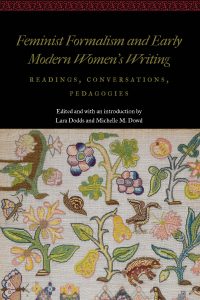 Michelle Dowd requires little introduction. She joined the English Department in 2016 as Director of the Hudson Strode Program, and while an established scholar in Renaissance and early modern studies, her renown is not just specific to her field. Her work unifies scholarship and pedagogy in a way that is beneficial to both students and colleagues. Her newest book, Feminist Formalism and Early Modern Women’s Writing: Readings, Conversations, Pedagogies, co-edited with Lara Dodds, is exemplary of how her work both breaks new ground in the field and provides useful practices for the classroom. I had the pleasure of interviewing Michelle about her book and her new, innovative approach to Formalism.
Michelle Dowd requires little introduction. She joined the English Department in 2016 as Director of the Hudson Strode Program, and while an established scholar in Renaissance and early modern studies, her renown is not just specific to her field. Her work unifies scholarship and pedagogy in a way that is beneficial to both students and colleagues. Her newest book, Feminist Formalism and Early Modern Women’s Writing: Readings, Conversations, Pedagogies, co-edited with Lara Dodds, is exemplary of how her work both breaks new ground in the field and provides useful practices for the classroom. I had the pleasure of interviewing Michelle about her book and her new, innovative approach to Formalism.
The book’s purpose, as Michelle states in its introductory chapter, is to reconsider “the relationship between gender and form in early modern women’s writing.” In doing so, she and Lara Dodds advocate for a new approach to formalist studies in early modern literature: Feminist Formalism. This approach examines the structures, techniques, and rhetorical modes (that is, the form) of early modern literature by taking “gender as a central category of analysis.” According to Michelle, Formalism is traditionally associated with mid-twentieth century New Criticism, which tended to disregard cultural or historical factors of a literary work and instead emphasized the study of text over context. Criticism of this approach, though, eventually gave way to New Historicism, Cultural Studies, and other theories that resisted New Criticism’s decontextualization of literary works.
Feminist Formalism, Dowd and Dodd argue, builds upon what has been deemed New Formalism (sometimes called Historical Formalism), which continues to examine formal elements of a text—such as genre, word choice, and poetics—but also combines those elements with broader contextual factors. While New Formalism takes a more nuanced approach than traditional Formalism, Dowd points out that it is nonetheless still primarily focused on the works of male authors, especially so in Renaissance Studies. Feminist Formalism has recently begun to gain traction as a means of literary enquiry more broadly, but it has not yet been consistently applied to Renaissance and early modern studies. “If you’re going to truly have a conversation about form in the early modern period, or any period really,” Dowd says, “female authors have to be part of that conversation because you’re going to get different kinds of answers, and you’re going to enrich the broader picture of literary history.” As a result, some of the genres we think we’re already familiar with might start to look a little different.
Dowd emphasizes, though, that Feminist Formalism is by no means limited to analysis of women writers. As in Feminist Criticism writ large, she says, “we need to think about gender as a category of analysis, regardless of who wrote the text.” Likewise, when analyzing the contextual implications of form, gender should be one of those contexts because, she tells me, it can reveal “how gendered tropes could play into certain types of imagery or how gender could dictate certain kinds of formal choices. Doing so can lead to different conclusions, sometimes surprising conclusions, or recognition of patterns we might have missed if we weren’t thinking about gender.”
 A unique illustration of this featured in the book is an essay by Edith Snook: “Margaret Cavendish and the Recipe Form in Poems and Fancies.” In the essay, Snook demonstrates how Margaret Cavendish adopts certain conventions of the receipt form. Snook’s analysis exemplifies how the study of nonliterary genres typically associated with women can, in turn, help to highlight the innovative contribution of women writers in early modern literary genres. Prior to the book, Michelle tells me that she and others have similarly looked at women’s receipt books, accounting records, women’s household manuals, and guidebooks for servants and domestic workers. One of the book’s aims, she says, was therefore to look at these types of forms, which may have previously “flown under the radar,” and consider them as genres within their own right.
A unique illustration of this featured in the book is an essay by Edith Snook: “Margaret Cavendish and the Recipe Form in Poems and Fancies.” In the essay, Snook demonstrates how Margaret Cavendish adopts certain conventions of the receipt form. Snook’s analysis exemplifies how the study of nonliterary genres typically associated with women can, in turn, help to highlight the innovative contribution of women writers in early modern literary genres. Prior to the book, Michelle tells me that she and others have similarly looked at women’s receipt books, accounting records, women’s household manuals, and guidebooks for servants and domestic workers. One of the book’s aims, she says, was therefore to look at these types of forms, which may have previously “flown under the radar,” and consider them as genres within their own right.
While the book charts new territory and broadens our understanding of early modern literary history, it is not solely for the specialist scholar. Another of its valuable functions is its guidance on implementing Feminist Formalism in the classroom. Part Three of the book offers sample assignments, in-class activities, and lesson plans that, the book states, “demonstrate the productive utility of a variety of feminist formalist methods in a range of classroom settings.” For instance, Lauren Shook’s “Collaborative Close Readings: Anne Vaughan Lock’s Sonnets in the Undergraduate Survey Course” models an analysis of Lock’s poetics within the Protestant Petrarchan tradition. Shook’s suggested classroom activities yield multiple benefits: they teach students about the history of the Reformation in England while simultaneously highlighting the formal innovations of women writers and their vital role in promoting and shaping the nature of the Reformation.
Shook’s chapter is just one example of the significant cultural impact of Feminist Formalism and Early Modern Women’s Writing. By taking gender as its central category of formalist analysis, the book is at once microscopic and macroscopic. As Michelle explains it, the “minutiae can point to the larger comparative, ideological, or literary issues.” Michelle’s and Lara’s book thus effectively reveals how Feminist Formalism can revise early modern literary studies in a way that broadens our understanding of not just the literature but the historical period itself. It provides a useful theoretical model of analysis, and, importantly, its inclusion of Feminist Formalism’s pedagogical applications illustrates how we can better relay this knowledge and practice to our students in a more encompassing and comprehensive manner.
–Adam Roberts